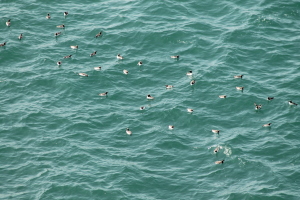Guillemot (Uria aalge)
Nevertheless, precipitous cliff faces are safe. No ground predator would risk scaling such dangerous rock walls, and any aerial marauder would be faced with a row of sharp bills. Once the egg has been laid, at least one parent Guillemot will be in constant attendance throughout the nesting period, on guard against danger. A little discomfort is a small price to pay for a successful breeding season.
Guillemots follow the typical pattern of low productivity for a long-lived species (they regularly live up to 20 years), by laying just one large egg a year, to which they devote all their energies. Being laid on bare rock high up on a ledge, the egg is pear shaped rather than round, ensuring that, should it roll it will have a tight turning circle and not fall off the cliff – although, since Guillemots are clumsy birds, this does happen quite often. The egg is also highly patterned, with all kinds of spots, speckles and squiggles, and each one is individually recognisable, which may ensure that the birds incubate the correct eggs. It is also possible that at times, if both adults do need to vacate the nest simultaneously, the unique egg can be found again as surely as in individually marked house.
The adults feed the youngster on fish, and they have a somewhat laborious way of doing it. They go out to sea, sometimes as far as 50 km, catch a single fish each time, and return 3-8 times a day, carrying it lengthways in the bill so that they head is embedded deep in the mouth, possibly to predigest the bony head. Such paltry efforts add up to about 28 g per day.
This goes on for three weeks and then the youngster, still flightless but highly capable of swimming, leaves the nest site. This is a fraught process, usually taking place in the evening before dusk, when the colony, highly synchronised to ensure that most young leave at the same time, becomes a tense, agitated place, ringing with the braying calls of anxious adults. Departure is highly risky, for several reasons. For a start the vulnerable youngster must jump off the cliff ledge, perhaps to descend 300 m before it hits the water. Its wings are weak and its progress downwards is fluttery and poorly controlled, and it must avoid hitting any rocks below. Secondly the departure of chicks is an opportunity for easy meals for gulls or skuas; they may pick the youngsters off from their “diving ledge” (not all jump from the nest site), intercept them on the way down, or field them from the water when they surface. And thirdly the youngster must rendezvous with its father when it gets to the sea, because otherwise it will starve. Although good in the water, it cannot catch enough fish to sustain itself until later, so for the moment must be provided for.
If father and young meet up successfully they swim out to sea together and remain as a unit for about a month. During this time they may cover 700 km or more while the youngster serves its fishing apprenticeship. The female parent, meanwhile, spends a couple of weeks resting at the colony, and then disperses out to sea to moult.

